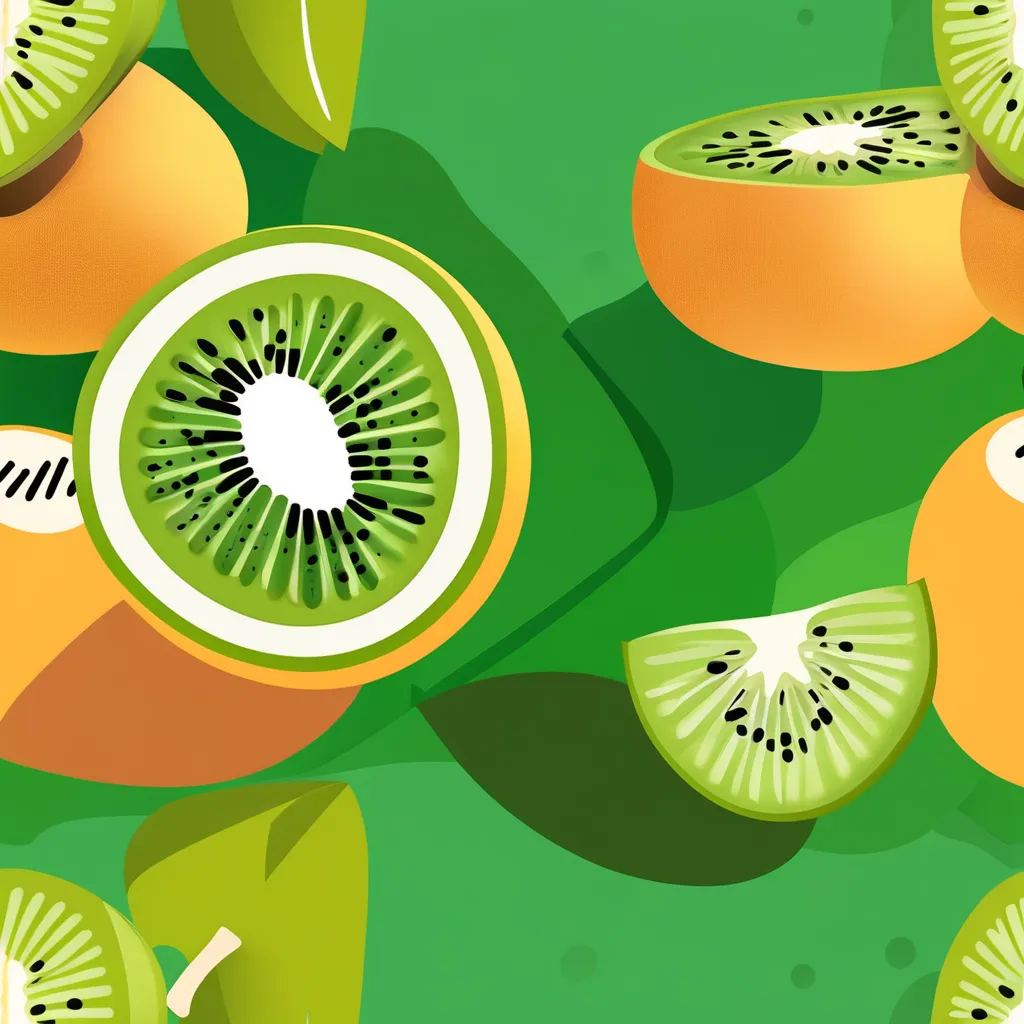Kiwi fruit, also known as kiwifruit or Chinese gooseberry, is a small, oval-shaped fruit with a fuzzy brown exterior and vibrant green or golden flesh inside. It’s known for its tangy-sweet flavor and its high vitamin C content.
Kiwi is a nutritious fruit that offers a range of health benefits. Here are some key advantages of including kiwi in your diet:
- Rich in Vitamin C: Kiwi is packed with vitamin C, which is crucial for immune function, skin health, and antioxidant protection. Just one kiwi can provide more than the daily recommended intake of vitamin C.
- High in Fiber: The fiber content in kiwi helps with digestion, promotes regular bowel movements, and can aid in managing weight by promoting a feeling of fullness.
- Supports Heart Health: Kiwi contains potassium and antioxidants, which can help reduce blood pressure and improve heart health. The fruit also has properties that may help lower cholesterol levels.
- Boosts Immune System: The high vitamin C and antioxidant content in kiwi enhance the immune system, helping the body fight off infections and illnesses.
- Improves Skin Health: Vitamin C and other antioxidants in kiwi can help in collagen production, which supports skin elasticity and helps reduce signs of aging.
- Enhances Digestive Health: Kiwi contains an enzyme called actinidin, which aids in protein digestion and can help alleviate symptoms of bloating and constipation.
- Anti-inflammatory Properties: The antioxidants in kiwi have anti-inflammatory effects that can help reduce inflammation in the body, which is beneficial for overall health.
- Supports Eye Health: Kiwi is rich in lutein and zeaxanthin, compounds that are important for maintaining eye health and may help prevent age-related macular degeneration.
- Blood Sugar Regulation: Kiwi has a low glycemic index and contains fiber, which can help regulate blood sugar levels and may be beneficial for people with diabetes.
In Nepal, you can cultivate kiwi fruit at altitudes ranging from 1,200 meters to 2,400 meters above sea level. If you plan to establish a kiwi garden at a high altitude, choose the south side of the hill. Mohada facing northeast at a height of 1,200 to 1,600 meters works well. To protect the fruit in areas prone to hail, use a hail barrier net. Kiwi fruit thrives in cool climates.
Identification of soil
As the temperature increases in February and Chaitra, buds begin to grow, flowers bloom in the buds, fruits start to develop, shoots grow, and the growth stops after Asoj and Kartik. When the temperature begins to decrease in November and Paush, the leaves fall off, and the plant goes into a dry state. Kiwi fruit requires cool temperatures for new growth. The average minimum temperature of 13 to 14 degrees Celsius and the average maximum temperature of 13 to 25 degrees Celsius during winter months are suitable for kiwi cultivation. An annual rainfall of 1500 to 2000 mm and relative humidity of 76 to 78 percent are ideal for growing kiwi.
Since kiwi fruit roots do not go too deep and spread on the upper surface of the ground, you should use light soil to allow the roots to grow. If you can manage the required amount of compost, you can cultivate kiwi in various soil types. Sandy loam soil with abundant organic matter and land with a good irrigation and drainage system are suitable. The soil pH should range between 5.5 and 6.5.
Varieties of kiwi fruit found in Nepal
Green-bellied female breeds: Hayward, Allison, Monty, Bruno and Avott
Male Breeds: Machuwa and Timori
Yellow-bellied varieties: Jaspery GoldRed-bellied breeds: Red Kiwi (female) Kohi Kiwi (male)
Planting time
The kiwi fruit plant falls under the category of winter and fall fruits because its leaves fall in winter. You should plant kiwi seedlings during the Poush and Magha months.
Preparation of Planting Pit:
After selecting the land for planting kiwifruit orchards, clean and prepare it. Dig a 3 feet wide and 3 feet deep pit four to five weeks before planting. Separate the soil from the top half of the pit and the bottom half of the pit.
Before planting, mix 40 kg of well-ripened cow dung, 50 g of urea, 100 g of D.A.P., 100 g of potash, and 1 kg of ash with the soil left after digging the pit. When digging the trench, place the top soil mixed with manure at the bottom and put the bottom soil on top. Since the soil settles after digging, make the trench one meter higher than the surface of the ground and bury a small stick in the middle of the trench to mark it.
How to plant ?
Male and female flowers bloom on separate kiwifruit plants, so you should adjust the ratio of male and female plants. Generally, you plant 1 male plant in the middle of 8 female plants, but it is considered better to plant 1 male plant in the middle of 5 female plants. First, plant the male plants and then place the female plants in between the male plants. When planting the plant, position it in the middle of the pit to avoid bending the roots. When you graft the plant with soil, make sure the jointed part stays in place. Support the plant with a 6-7 feet long bamboo stick and tie it lightly. Then, water the plant to ensure the soil gets wet.
Manure Management
Kiwi plants need a lot of fertilizer due to their large leaves, many roots, and fast growth. In the first year, use 30 kg of fertilizer per plant with 100 g Urea, 200 g DAP, and 150 g Potash. In the second year, apply 30 kg of fertilizer, 200 g Urea, 300 g DAP, and 300 g Potash. For the third year, use 60 kg of fertilizer with 500 g Urea, 500 g DAP, and 400 g Potash. From the fourth year, apply 60 kg of fertilizer, 500 g Urea, 500 g DAP, and 500 g Potash each year before flowering. Sprinkle all Gobarmal, DAP, Potash, and half the Urea around the plant’s base and water thoroughly.The remaining half of the urea should be used in June and July.

